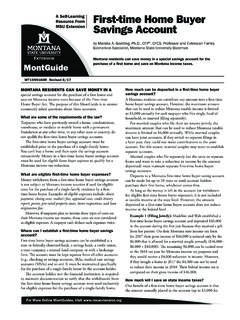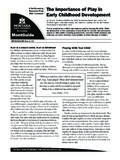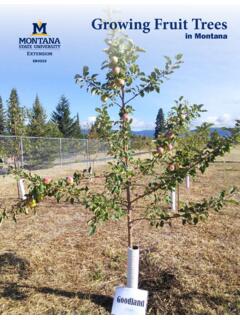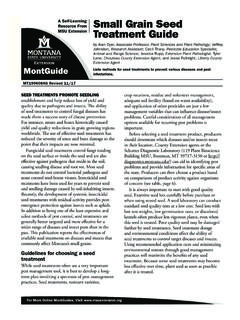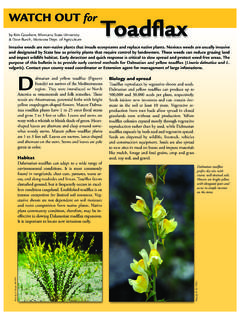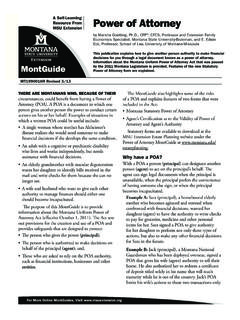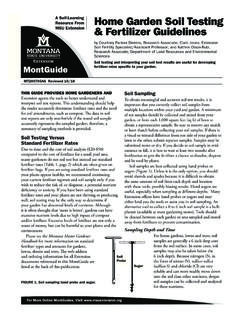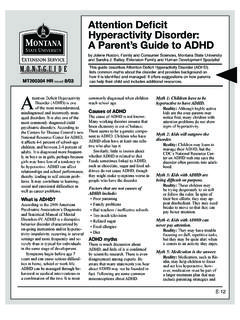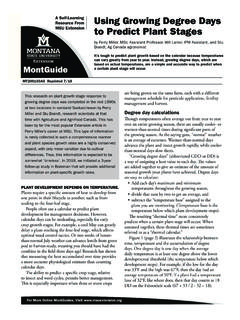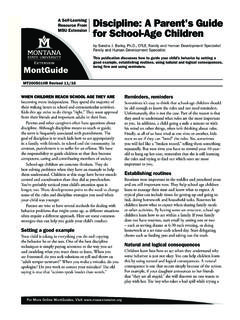Transcription of MONTGUIDE - MSU Extension
1 I-1 AgricultureMT 8380byRodney Kott, Extension Sheep SpecialistWool GradingCertain qualities such as fineness, length, colorand appearance determine the end use and valueof wool. Fineness the fiber diameter, or grade,and its distribution is one of the most importantof these quality factors. Fineness largely deter-mines whether the wool is used in a suit, sweater,blanket or in a pair of general, grade refers to the average diam-eter or thickness of the fibers. Three systems ofwool grading are commonly used in the UnitedStates: American or Blood system; the English orSpinning Count system; and the Micron three systems are measures of average fiberdiameter and can be related to each other (Table1). In actual practice, they are used American or Blood SystemThe American system of grading wool was de-veloped in the early 1800s when the nativecoarse-wooled sheep were being bred to fine-wooled Merino rams imported from Spain.
2 It as-sumes that the offspring of the cross wouldhave fleeces which were intermediate in finenessbetween the two parents. The wool grade is de-fined as the percentage of Merino blood carriedby the sheep that typically would produce a par-ticular fineness of wool. The grade or fiber diam-eter came to be expressed as fine, 1/2-blood, 3/8-blood, 1/4-blood, low 1/4-blood, common andbraid (Figure 1). Today, these terms are not asexact as the trade would prefer, and the spreadwithin a grade is too broad to suit the purposes ofwool English or Spinning Count SystemThe English system of grading wool providesnarrower ranges and a more exact nomenclaturethan the American system. It uses a measurementcalled the spinning count and is based on thenumber of hanks of yarn which could be spunfrom one pound of clean wool on the equipmentavailable at the time the system was wool becomes finer, more hanks or yards ofyarn can be spun from a pound of clean wool andthe spinning count becomes larger.
3 In theory, onepound of clean 62s spinning count wool couldproduce 62 hanks or 104,160 feet of yarn. (A hankof yarn is 560 yards in length.) Although wool isseldom spun to its maximum count, there is alimit to the number of fibers which will hold to-gether in yarn. The English or Spinning Countsystem of grading wool provides a numericaldesignation of fineness. English or SpinningCount grades of wool commonly used in theUnited States today are: 80s, 70s, 64s, 62s, 60s, 58s,56s, 54s, 50s, 48s, 46s, 44s, 40s, and 36s (Figure 2).The Micron SystemIncreased emphasis on an exact and highly de-scriptive method of describing wool grade hasproduced a measuring system in which indi-MONTGUIDET able 1. Relationship Between the American, English and Micron Systems of Grading WoolVariabilityEnglish orLimit forType ofAmerican orSpinningMicron (range inStandard DeviationWoolBlood GradeCount Gradeavg.)
4 Fiber diameter)Maximum (microns)FineFineFiner than 80sUnder 1/4 1/4 CoarseBraidCoarser than 36sOver fibers are accurately measured. The unit ofmeasure is the micron, which is one millionth ofa meter or 1/25,000 of an inch. Fineness is ex-pressed as the mean fiber diameter. Eventually,this system will become the standard for describ-ing wool in the United of Grade or Fiber DiameterThe use and value of a fleece or lot of wool isaffected almost as much by the distribution of theindividual fiber diameters as the average fiber di-ameter or grade. The more uniform the indi-vidual fibers are in diameter, the more average fiber diameter or grade impliesnothing about its distribution within a givenquantity of wool. For instance, a lot of wool maycontain 50 percent of its fibers at 35 microns andthe other 50 percent at 15 microns and still havethe same average fiber diameter 25 microns as a lot of wool with only 1 percent of its fibers atthese extremes.
5 A measure of the amount ofvariation in fiber diameter within a given lot or64s48s50sFigure 2. Relative diameters of some ofthe English or Spinning Count woolgrades (x 500 magnification).1/23/81/4 Low 1/4 CommonFineBloodBloodBloodBloodand BraidFigure 1. Relative diameters of the American Wool Grades (x 500 magnification).fleece has been added as a quality factor to moreaccurately describe the wool being DeviationThe measure most commonly used to describethe distribution of measurements about an aver-age is the standard deviation. The average fiberdiameter plus or minus the standard deviationwill encompass roughly two-thirds of all the in-dividual fiber diameters. The more variable thewool is, the larger the standard deviation and thelower the quality. The ASTM (formerly theAmerican Society for Testing Mater)ials has setup standards for the fiber diameter and variabil-ity of the various grades of wool (Table l).
6 Thisstandard is based on the average fiber diameterof a sample and the actual distribution of fiberswithin that fineness range. It prescribes a certaindistributional requirement a maximum allow-able standard deviation to meet standard speci-fications and makes allowances for distributionaldifferences of given grades. If a lot or sample ofwool fails to meet the distributional characteris-tics of that grade, has a larger standard devia-tion than that allowed for that grade, the wool islowered to the next spinning count grade. Inshort, variation is expressed in terms of the stan-dard deviation and wools with greater variabil-ity than allowable for a particular grade are auto-matically placed in the next lower of VariationAnother useful concept in describing the uni-formity of fiber diameter within a given quantityof wool is the coefficient of variability.
7 It ex-presses the variation as a percentage of the aver-age and is usually used when one wishes to com-pare the variances between two or more lots ofwool with differing average diameters. A stan-dard, based on the coefficient of variability, hasbeen derived in recent years for field work withwool. This standard is shown in Table 3. Uniformity of Wool as Expressed by aCoefficient of VariationCoefficient ofStandardofVariationUniformityLess than to Justabove flanklevel andhalfway be-tween the flankand rear of thesheepFigure 3, Parts of the sheep from which to takesamples for Micron testingASide At thesecond-to-lastrib, middle ofthe sheepThe Micron TestAlthough an experienced wool grader canusually estimate wool grade fairly accurately,there are exceptions. Even the most experiencedwool graders will be wrong some of the or later most wool will be micron tested,either by the producer, the buyer or at the textilemill.
8 A micron test may not always tell the pro-ducer what he wants to hear, but it will tell thetrue the SampleThe normal method of obtaining a samplefor micron testing is taking a core test fact, the cores drawn for clean yield or shrink-age determination are adequate and can also beused to estimate fineness and variability of alot of wool. For selection purposes, microntests can be run on samples taken from indi-vidual sheep. The most economic way is to cuttwo square inches of wool from the areamarked A in Figure 3. Remember, this mea-surement will not indicate the amount of fiberdiameter variation between the individual sside and britch, the area marked B in degree of this variation, however, is veryimportant. It should be assessed visually. In somesituations producers may also want to have abritch sample micron tested.
9 Micron testing botha side and a britch sample should provide a gen-eral overall picture of the fleece AnalysisOnce a representative sample has been taken itshould be packaged and sent to a wool testinglaboratory where the average fiber diameter, thestandard deviation and/or coefficient of variationcan be determined. Assistance in insuring that arepresentative sample is taken and names andFile under: SheepI-1 (Wool Production and Marketing)Reprinted July 1993 2761000793 MSaddresses of laboratories where this analysis isperformed, can be obtained from the StateExtension Sheep Specialist, Rodney Kott, 994-3414, or the Montana Wool Laboratory, more pointMicron testing a lot of wool that is extremelyvariable will be of little value since the standarddeviation will be so large that the test results willbe almost impossible to interpret.
10 Wool pools, inparticular, will usually fit this category since theyoften are a collection point for many differenttypes of importance of grade or fiber diameterand its distribution within a given lot or fleeceof wool in the textile industry cannot beover-emphasized. Research has shown fiberdiameter to be the most significant feature de-termining the physical characteristics of thefinished fabric. Manufacturing properties,such as spinning limits, yarn regularity andsoftness of the finished garment, are directlydependent upon fiber diameter.
